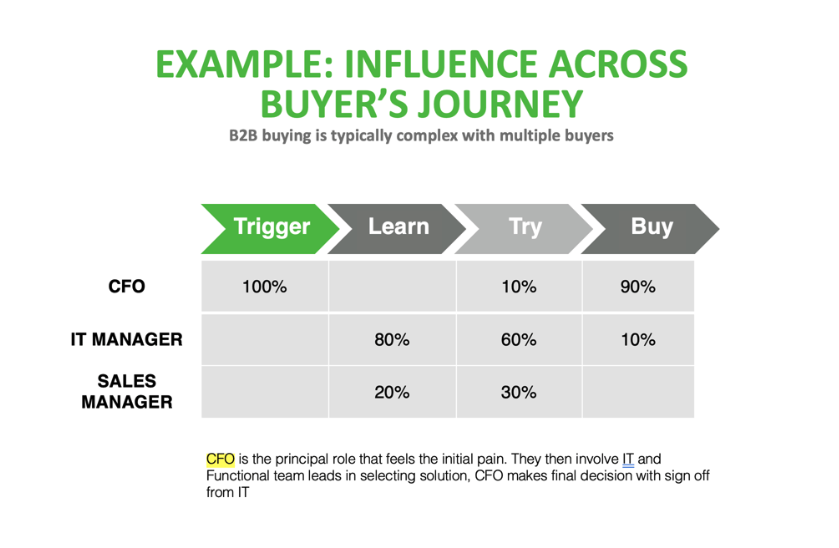Perhaps B2B sales and marketing professionals tasked with generating leads and closing deals should spare a thought for those individuals tasked with buying solutions for their organisation.
Buying B2B solutions for one's organisation is a long hard slog. Gartner says the median B2B buying group consists of between 6 and 10 people. Each of these people need four to five pieces of information to help them. Usually, around 83% of the time they have gone and sourced this information themselves.
Then starts the painful process of achieving consensus amongst the buying group and forming a concrete action plan. Brent Adamson, a Gartner distinguished VP, puts it this way.
"The hardest part about B2B solutions isn't selling them but buying them. Today's buying journey has effectively reached a tipping point where it's become unnavigable without a significant amount of help"
Showing you understand the challenge B2B buying centres face, showing empathy for their plight and providing information and tools that aim to reduce this purchase friction is the secret to building an authentic and trusted relationship with your target audience.
How do you achieve this?

The answer lies in rethinking your go-to-market and content strategy. Both sales and marketing must agree and align:
1. Around the buyer's purchase process, not your internal sales and marketing processes. Does a buyer really say to themselves, "I am now a qualified lead, how exciting!" Of course not, but they might well say, "I have researched how to fix this problem I have and now I think I can clearly express what I need." Your go-to-market tactics and the messages reflected in the content you share must reflect the path your buyer is on. Its goal is to move them from stage to stage of their buying process.
2. Develop a consistent set of messaging aligned to the buyer's journey. The messaging reflected in your content and your sales playbook should change as a buyer moves through the four buying stages. Your sales and marketing teams MUST be aligned around these messages. TrustPathTM, our go-to-market messaging methodology describes these stages as:
- Trigger: The pain point that gets so bad an organisation decides it must take action to fix it.
- Learn: Individuals in the organisation research different options to fix their problem, they determine "what good looks like."
- Try: The organisation whittles down their options by trying various solutions to their problem
- Buy: The key decision maker decides on their preferred solution.
3. With the right content aimed at each specific buyer influence, the task is to deliver that content through the right channel. This might vary from a salesperson in a discovery meeting (the Try stage) to a social post (the earlier Trigger stage). B2B firms are realising in a post Pandemic world where digital fatigue is at an all-time high, they have to improve their content strategy game if they are to have influence successfully across the full purchase cycle and must involve BOTH their marketing AND sales teams.
To describe the types of individuals in a complex buying centre we have turned to Miller Heiman's strategic selling methodology that has been the backbone of many B2B organisations' sales process where they are faced with a complex sales environment. Its a powerful, proven technique and we thoroughly recommend learning more about it through the many books and courses that are available, but here is a summary of the influencers they describe:
1. The Economic Buyer
They want to: Evaluate ROI (Return on Investment).
They look at: Case studies, client examples, and financial models and tools that showcase the ROI of a solution.
This buyer holds the purse strings, plain and simple and is therefore the most important of the influencers. Often they are the most senior person , though not always. They often evaluate the broader business impact of your solution. Will it increase revenue or reduce cost, drive up their margins or allow them to enter new markets and so on? They'll also evaluate the business risk associated with choosing your solution. For example, if your company goes out of business, loses key team members, or gets acquired, what effects will that have on their project.
Ask about strategy and then show how your solution will help them achieve their long-term objectives. There is always only one Economic Buying Influence per sale.
2. The User Buyer
They want to: Evaluate user experience and operational impact.
They look at: Hands-on aspects of your solution, like free trials, demonstrations, training and user documentation and so on.
They will be linked personally to your solution and judge it based on the impact it will have on their specific job performance. This person needs to know how your solution will be used on a daily basis, and who it will affect. They tend to consult with peers in user groups or community sites to see what others who have implemented your solution are saying about it. Their investigations can be extensive and granular and will often focus on change management. The economic buyer will rarely proceed if they get a red light from The User Buyer.
You should ask pain-based questions about their current situation to User Buyers.
3. The Technical Buyer
They want to: Evaluate feasibility.
They look at: Contractual terms and conditions, trials, demonstrations and compliance.
Commonly, The Technical Buyer will be the CTO, CFO, or IT Manager. When evaluating your solution, they'll ask, “Does this mean I’ll have more work to do?” “Could we develop this ourselves?” or “There are other better options out there, although I don’t know them.”
Typically they can’t say “yes,” but they can say “no”. There may be more than one Technical Buying Influencer per sale, for example IT and Finance must both sign off on the deal.
4. The Coach
They want to: See your solution implemented.
They look at: Marketing and sales material that can be used for internal promotion of your offer.
The Coach is your champion within the organisation – An individual who guides you in the sale by giving you information that you need – a very influential role who can significantly assist in getting you the order and repeat business.
Buyer Personas That Actually Work
An early job for those tasked with developing your B2B go-to-market strategy (hint: it should include both marketing and sales as a minimum) is to develop buyer personas - fictitious representations of your ideal customer, the individual you wish to target.
A good buyer persona goes beyond simple demographic information and a description of their personality. Additionally and more importantly a good persona will describe:
- Their organisation's goals. Typically encapsulated in their KPIs.
- Their personal goals. What ambitions do they have for themselves?
- The key challenges that are preventing reaching their professional AND personal goals
- The impact these challenges have on their organisation
- The personal implications for that decision maker.
Armed with this information, imagine how well-placed you would be to help your buyer. And later in the buyer's path, when it comes time to present your solution, how you will be able to show how the features and functions of your solution will help them reach their goals.
How do I start this process?
TrustPathTM is g2m solutions's methodology for helping our clients build their go-to-market messaging, tools and tactics and we always start with a Key Decision Maker (KDM) matrix, that determines who wields influence across the buying journey. Here is a hypothetical example:

With this clear you can then:
- Build messaging for your sales and marketing team to use for each buying stage
- Develop a mix of content, information and tools that help your buyers move from stage to stage
- Intentionally design sales and marketing campaigns that move buyers from stage to stage
- Build these campaigns into your sales and marketing automation tools to embed effectiveness into your go-to-market strategy
If you are interested in understanding how we can help please feel free to contact us or book a time for an initial discussion or visit our TrustPathTM page.

